Sewerage cleaning: 4 ways to deal with clogged pipes
Sewage cleaning is a fairly routine exercise: sooner or later, each of us will either have to eliminate the blockage on our own, or seek the help of specialists. And in order to save on payment for their services, it is better to study in advance the most affordable and effective methods for removing traffic jams from pipes.
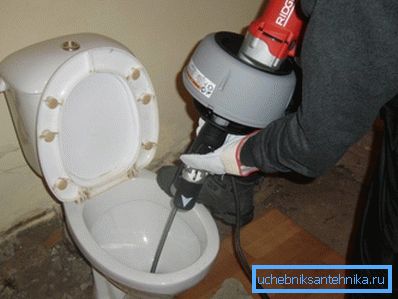
Why are blockages formed?
Before analyzing the cost of cleaning the sewage system and studying the most effective ways to solve this problem, you need to figure out why the blockages do arise.
There may be several reasons for this:
- The most common phenomenon is the so-called operational blockage.. It is formed as a result of a narrowing of the internal lumen of the pipes, caused by accumulation of fatty deposits on the walls in certain places. Most often, such blockages are formed in homes without centralized hot water: cold water dissolves fat worse and it settles in much larger quantities.
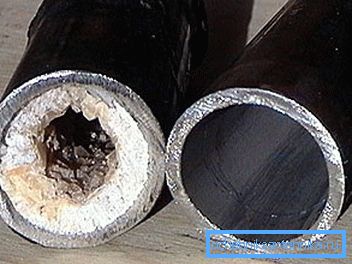
Note! The rate of clogging largely depends on the material of the pipeline. So, for cast-iron pipes with a roughness factor of 0.45 mm, cleaning may be required every three to four months, but plastic sewage (roughness of 0.02 mm or less) should be cleaned less than once a year.
- The second problem is related to sewer system design errors.. Insufficient inclination or too sharp rotation of the pipe leads to a slowdown in the movement of wastewater, and in this place a cork is formed rather quickly.
- Internal defects in pipe joints can aggravate the situation: even the smallest burr serves as a kind of anchor for hair to be washed off in a bath or shower.
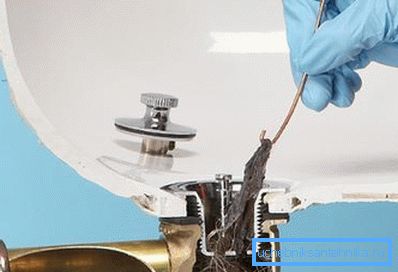
- Finally, a blockage can be caused by a large object that simply does not pass through its internal diameter.. In this case, emergency cleaning of the sewage system is required, since the flow of the drain will either be blocked completely or it will be very difficult, which will make it impossible to operate the system.
Having determined which factors have caused the problem in our case, we will be able to decide how to clean the sewage in the apartment with maximum efficiency.
Removal methods
Method 1 - Flushing
In this section, we will tell you how to clean the sewer system in a given situation, starting with the simplest methods and ending with the most laborious ones.
And first of all, we will consider a technology that allows you to prevent serious problems - flushing with hot water:
- As soon as we notice that the drainage rate in the kitchen or bathroom sink has decreased, it can be stated with certainty that a sufficiently thick layer of fat accumulates on the walls of the pipes.
- To remove such contamination, it is sometimes sufficient to simply turn on the hot water tap for a few minutes. By performing this operation once a month, we can prevent the narrowing of the lumen of the tubes.

- If such flushing did not help, you will have to act more radically. On the stove, we heat up about 3 liters of boiling water, cool it to a temperature that our pipes can withstand and pour into the sink. A large amount of hot water can quickly dissolve even a massive fat plug.
Note! Pouring boiling water into the sewer is not worth it: most pipes are designed to heat up to 950C, and their compounds can be deformed by strong simultaneous heating.
Method 2 - the use of household chemicals
If there is not enough hot water to clean the sewage system, you can proceed to the use of more efficient methods, namely the dissolution of organic matter with chemical reagents.
- The simplest method involves the use of what is in each kitchen: about a quarter cup of soda is poured into a drain, which we fill with the same amount of vinegar. After about half an hour, thoroughly flush the pipe with warm water.
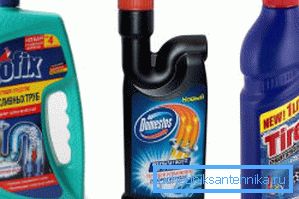
- If the soda with vinegar did not help, it is worth buying a special tool to remove blockages from the pipes. The cost of such compositions is not too high, but most of them demonstrate satisfactory performance.
- Using special tools for cleaning pipes, you must strictly adhere to the instructions: the principle of the reagent can be very different, and therefore the effect can be achieved only with proper use.
Note! In no case can not increase the dosage of funds, and the more to mix different compositions. Most often the result of such experiments is damage to the sewer pipeline.
Method 3 - plunger
If the cork has a mechanical nature, that is, the pipe is simply blocked by solid objects, you can try to push the blockage under pressure with your own hands using a plunger.
For this:
- In the bath or sink close the overflow hole.
- We collect a small amount of water - about as much as the rubber part of the plunger is completely covered with liquid.
- Install the plunger on the drain and tightly pressed to the edges of the hole.
- We pump the system, gradually increasing the amplitude and intensity of the movement of the handle.
- A sharp movement pulls out the plunger, creating a negative pressure in the pipe.
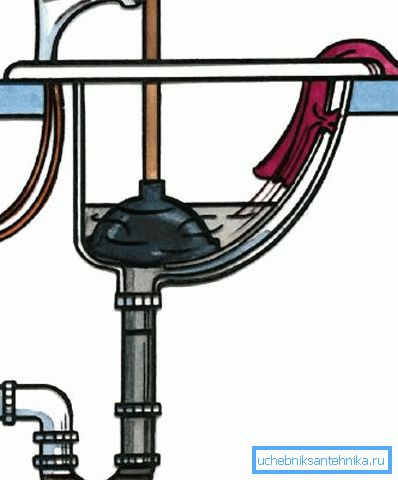
Repeating these operations several times, you can destroy even the densest blockage.
Method 4 - Mechanical Destruction
In some cases, neither household chemicals nor plunger help. This usually happens when a lump of hair, household garbage and bulky waste is formed in the pipes, which interferes with the flow of water. In this case, it is necessary to destroy the barrier with a cable or similar devices.
In principle, in a difficult situation it is worth asking for help from specialists.
But if, having learned how much it costs to clean the sewage (for Moscow apartments, this service will cost from 5 thousand rubles and more), you will want to master the technique yourself - read the instructions below carefully:
- For cleaning we get a special cable. It can be equipped with either a simple handle or a special device to facilitate rotation.
- We determine the approximate location of the blockage and try to get access to the “insides” of the pipe as close as possible to this point. The easiest way to do this is to use special inspection hatches (an example is shown in the image below).
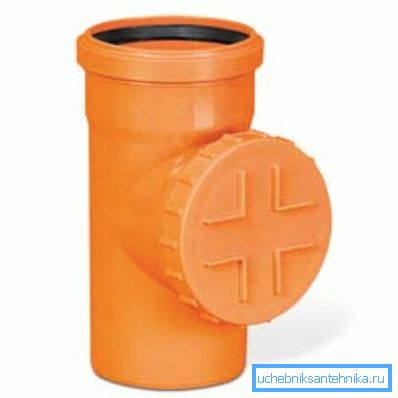
- Then we work together: one guides the cable through the pipe, the second rotates the handle for the effective destruction of the blockage. At the same time we try to make reciprocating movements, since in this way we will be able to “pull” the cork much faster, and then the remnants can be simply washed with water.
Note! In a similar way (only, of course, with the use of more powerful tools) mechanical cleaning of storm sewage is performed.
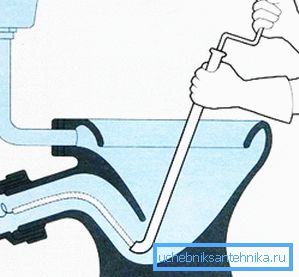
- If it didn’t help either, you will still have to contact specialists who, with the help of a special apparatus, will perform hydrodynamic destruction of barriers in the pipeline. To do this, a special nozzle on the hose is inserted into the system, through which water is pumped under pressure, washing away the densest clogging in literally minutes.
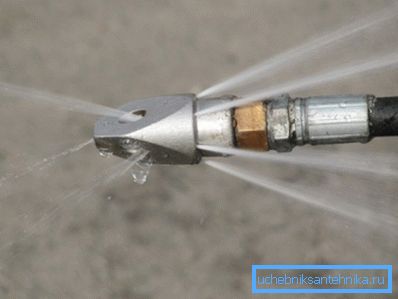
Conclusion
Clearing the sewage with your own hands in most cases is quite possible. The main factor that determines the success of our actions is the correct identification of the causes of the problem and finding the exact place of blockage in the sewage system. Having coped with this and following the instructions on the video in this article, we will restore the permeability of the drainage system with minimal effort.